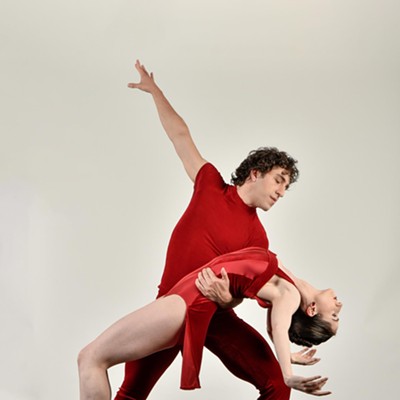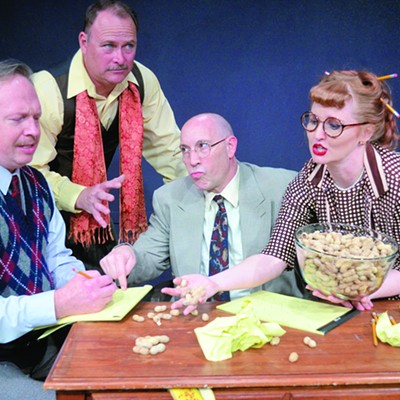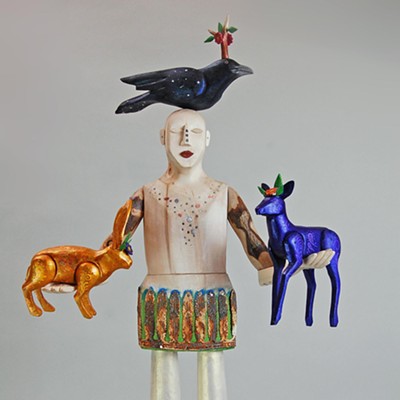The Brothers Gershwin
Gershwin, by Ira3 p.m., Sunday, March 25
Berger Performing Arts Center
1200 W. Speedway Blvd.
400-5439; www.cmpsouthwest.org
Many folks are familiar with George Gershwin, author of such musical compositions as "Rhapsody in Blue" and "An American in Paris." But what about his brother, Ira? Ira wrote music, too--with absolutely brilliant lyrics. It took the combined talents of both brothers to create many famous songs like "I Got Rhythm" and "The Man I Love," and Ira should get at least as much credit as George for creating the opera Porgy and Bess and the musical Lady Be Good.
Well, today, there's a musical that features all the best work of the Gershwins and implicitly gives credit to both of them--although the show wasn't actually written by either. Gershwin, by Ira is a biographical portrait of George's life seen from the perspective of his brother and collaborator, following the Gershwins through their childhood together in New York City, the beginnings of their respective careers and their work together on Broadway. Finally, the production portrays the brothers' later life in Los Angeles, where they worked on movies, and where George met an early death at 38.
"I am doing this in the character of Ira Gershwin, as he is often overlooked--certainly in his relationship with his brother," said Harry Clark, the author of the musical, in an e-mail. "The other wonderful thing is that because he is a 'words man,' the dialogue sparkles with his wit."
The show, to be put on this weekend by Chamber Music PLUS Southwest, will feature a lot of well-known Gershwin songs in addition to some rarely heard, funnier works that were originally written as party songs. Tucson Jazz great Jeff Haskell will play piano; Katherine Byrnes and Allen Goltz will sing; and Harold Dixon will star as Ira Gershwin.
Tickets are $30, or $23 for Chamber Music PLUS subscribers; students get in for $12.50. A pre-show chat will take place at 2:30 p.m. --A.M.
Fire Escape
Wildfire Presentation6:30 to 7:30 p.m., Tuesday, March 27
Bookmans
1930 E. Grant Road
623-5252, Ext. 312
It's almost forest fire season. That can be a very scary time, especially in the dry Southwest. But it can help to know how and why forest fires happen--and some facts may surprise you.
According to photographer, author and ecologist George Weurthner, the fires we hear about on the news every summer occur not because there are so many trees to fuel them, but because of extreme environmental conditions like drought, strong winds and low humidity. This means that our government's current forest policy--which is based largely on the notion of "thinning," or cutting down trees to reduce the intensity of fires--isn't helping at all. Actually, Weurthner says, thinning often increases fire risk and intensity, because it opens up forests to wind, reduces moisture and encourages more rapid growth of residual vegetation. Some of the worst recent fires have been in thinned forests.
Perhaps the most counterintuitive thing Weurthner says about forest fires is that, when they're not huge and out of control, they can really be good for the landscape. Under normal conditions, wildfires are small and manageable, and are a natural part of the lifecycle of a forest.
With all this in mind, no one wants their house or cabin to burn down. So what's the solution? Weurthner says it's all about making homes fire safe. "If we can make our communities more defensible and stop the continued building of homes amid fire landscapes," he asserts, "we can allow wildfires and prescribed burning to provide the positive influences of fire."
Weurthner will share more information--plus some incredible photographs--during his presentation this Tuesday. Copies of his latest book, Wildfire: A Century of Failed Forest Policy, will be available, and the event is free. --A.M.
Hope Found in Art
Arts for All Holds Laser Art Technique ExhibitionEnds Tuesday, March 27
Hope IV Art and Culture
951 E. 35th St.
622-4100, artsforallinc.org
In 2002, Arts for All began working with a technique called the Laser Art Technique, or L.A.T., to enable people with limited mobility to create art. In the past, people who had various forms of limited mobility had been virtually unable to create forms of art that were exclusively their own, and the L.A.T. enables many disabled people to do so.
People who use the L.A.T. wear custom headgear, which has a laser mounted on it. Using a tracker, or a trained set of hands for the artist, the immobile artist can direct the laser to create various forms of art in all different types of mediums.
Harriet Morton is a tracker for many immobile artists who use the L.A.T. at Arts for All, as well as an arts and ceramics teacher.
"The artists use me as a designated paint brush," says Morton.
Morton says that the art created by the disabled artists is transferred onto a canvas, and that many of the artists do very tight work and have equally tight control with the L.A.T. laser. However skilled the artwork is, creating art through the L.A.T. can be very time-consuming, because the lines and shapes are being directed through a small laser.
"If you talk to any of the artists, they will tell you their work is strictly their own," says Morton. "It's so important that the integrity is there."
The Laser Art Technique Exhibition is open to the public and can be seen up until Tuesday, March 27. For more information, visit the Arts for All Web site; call 792-3617 for gallery hours. --K.H.
Frida's Threads
Arizona State Museum's Culture Craft Saturday1 to 4 P.M., Saturday, March 24
Arizona State Museum
1013 E. University Blvd.
621-6302; statemuseum.arizona.edu
What would Frida Wear? The Arizona State Museum is asking that very question.
Frida Kahlo wore fantastic examples of traditional Mexican clothing that reflected political ideals and other expressions. The Arizona State Museum is exhibiting various forms of Mexican traditional dress that Frida herself might have worn, from the museum's Donald and Dorothy Cordry Collection.
The Cordry Collection consists of more than 1,300 clothing items, as well as Mexican Indian costume items such as belts, bags, tortilla cloths and huipiles. What are tortilla cloths and huipiles, you might ask? Tortilla cloths are used to transport and serve tortillas, and huipiles are square garments with a hole cut at the top for the neck, according to Darlene F. Lizarraga, marketing coordinator for the Arizona State Museum. Mexican masks, jewelry and costumes will also be on display.
"People will be given the opportunity to talk to the curators about the costumes," says Lizarraga.
This opportunity to check out some colorful and traditional Mexican threads is fun for children, too. All children who attend will receive a paper doll of Frida, as well as cutouts of traditional clothing.
The display of clothing will be spiced up with a performance by dance groups Grupo Folklorico Las Estrellas de Roskruge and Ballet Folklorico Tapatio. Wish you could learn how to twirl like these dancers? Free dance lessons will be offered by each group following their performances.
All of the museum's other exhibits will be open as well, says Lizarraga.
This chance to get a glimpse at what Kahlo might have worn is free and open to the public. For more information, visit the State Museum Web site. --K.H.







